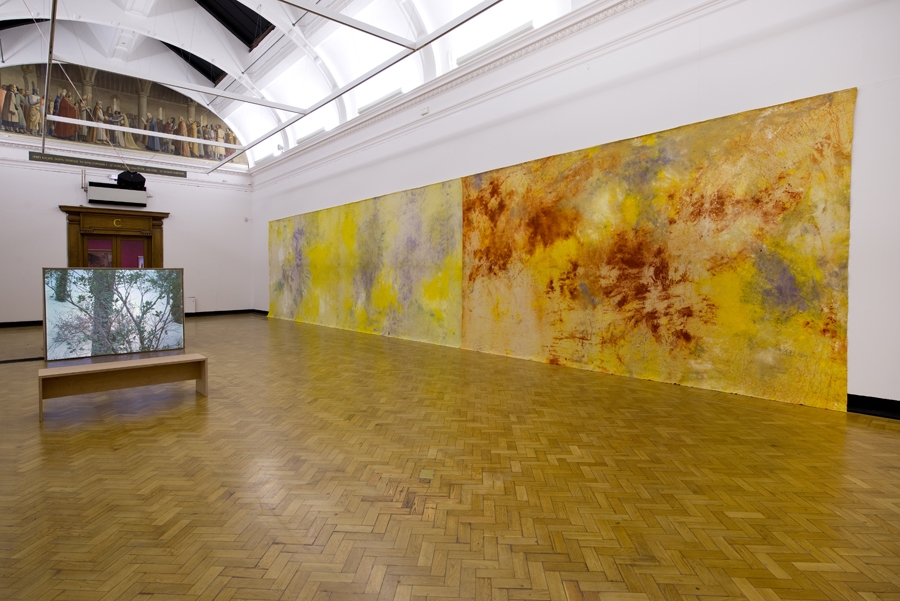In 2002, the price of indium, the heavy metal leached from slag and the dust of zinc production, hovered around $94 per kilogram. Today it’ll set one back up to $740. The reason for this remarkable upshot in the element’s international trading price stems from its use in the production of LCd screens. LCd screens that adorn flatscreen televisions like the one Hito Steyerl menaces with a hammer and chisel in her 28-second looped video Strike (2010).
The connection between raw material and its consumption by the immaterial systems of global capitalism is the main theme running through Metal, a group show of five artists at Middlesbrough Institute of Modern Art, which forms part of the AV Festival, a biennial programme of art, film and music in the northeast of England, now in its sixth iteration. It is a subject the curators are happy to plot transparently through the selected works. So while a video like Mathieu Kleyebe Abonnenc’s An Italian Film (Africa Addio) (2012), in which a Yorkshire foundry reenacts the nineteenth-century colonial-era melting and recasting of looted Congolese copper treasures, is perhaps an obvious one to include, it nonetheless keeps the curators’ narrative ticking over without, for better or worse, too many tangents for the viewer to get lost among.
The viewer can happily follow this line of thought through Anja Kirschner & David Panos’s film collage Ultimate Substance (2012), in which scenes of slaves (supposedly from Greek antiquity) smashing rocks intermingle with images of furnaces and antique coins; and on to the four scratched and scuffed half-metre copper cubes huddled in the corner of the gallery. These are examples from Walead Beshty’s 20-Inch Copper series (2009), in which the artist sends the works, without packaging, through FedEx to any gallery that wishes to show them. The surface damage, alongside the courier labels, is a souvenir of the sculpture’s time in transit and a deceptively simple, but brilliantly effective, testament to globalisation and networked labour.
Partnering Metal is a second thematic show, Stone, staged at the Northern Gallery for Contemporary Art in Sunderland. If Metal was about the effect that nature has on social and economic structures, then this deals with our environmental impact on nature. The theme is introduced via Gabriel Orozco’s video Boulder Hand (2012), in which a hand is shown rubbing a stone, the infinite looping of the image suggesting that it was this action itself that resulted in the stone’s highly polished surface. This is a bigger, much looser show than its partner. From the ten artists exhibited, highlights include Thiago Rocha Pitta’s Danae nos jardins de górgona ou saudades da Pangeia (2011), a 15-minute romantic video documenting a trickling saplike substance meandering over rock crevices and into the sea; Il Capo (2010), Yuri Ancarani’s sublime portrait of an active quarry, the workers dwarfed by the manmade landscape; and Transmission (2007), Harun Farocki’s engrossing 43-minute film detailing pilgrimage sites, from Washington’s Vietnam Veterans Memorial to the worn feet of the statue of St Peter at the Vatican, united in their use of natural stone.
From these two central curatorial essays – and they definitely feel like they have an authorial voice – the rest of the festival concentrates on various solo presentations, from Jessica Warboys’s painterly installation and accompanying video at the Laing Art Gallery to Rossella Biscotti & Kevin van Braak’s minimalist reimagining of Soviet-era figurative sculptures in a shopfront gallery on platform one of Middlesbrough Railway Station. In the central chamber of Newcastle’s grandly beautiful Mining Institute, Anna Molska’s 2009 film The Weavers is shown: it’s a portrait of a rather desolate contemporary Polish mining community, but Molska has given the miners lines from Gerhart Johann Hauptmann’s 1892 play of the same name (dubbed into English in this version), which chronicled an 1844 textile workers’ revolt. Molska seems to suggest that despite the nature of our abstract, global networked economy, and the supposed ideals of freemarket capitalism, most of the world remains chained to the land.
This article was first published in the Summer 2014 issue
